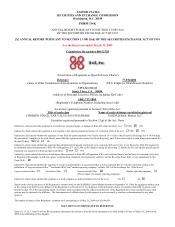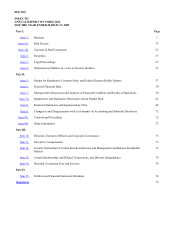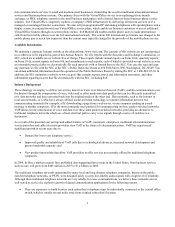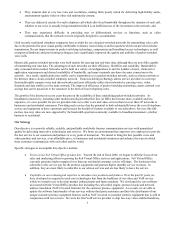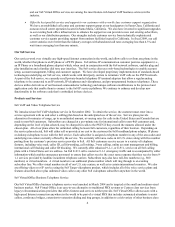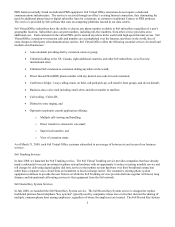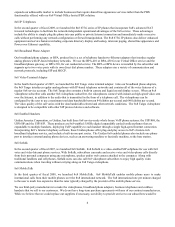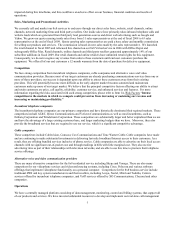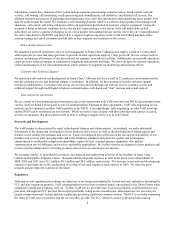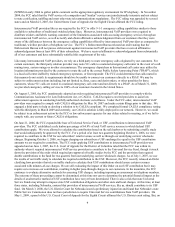8x8 2009 Annual Report Download - page 10
Download and view the complete annual report
Please find page 10 of the 2009 8x8 annual report below. You can navigate through the pages in the report by either clicking on the pages listed below, or by using the keyword search tool below to find specific information within the annual report.8
information system. Key elements of this system include customer provisioning, customer access, fraud control, network
security, call routing, call monitoring, media processing and normalization, call reliability, and detailed call records. Our
platform monitors our process of digitizing and compressing voice and video into packets and transmitting these packets over
data networks around the world. We maintain a call switching platform which is a software-based product that manages call
admission, call control, call rating and routes calls to an appropriate destination or customer premise equipment. Unless the
recipient is using an Internet telephony device, the packets (representing a voice and/or video call initiated by an 8x8
subscriber) are sent to a gateway belonging to one of our partner telecommunications carriers where they are reassembled and
the call is transferred to the PSTN and directed to a regular telephone anywhere in the world. Our billing and back office
systems manage and enroll customers and bill calls as they originate and terminate on the service.
Network Operations Center
We maintain a network operations center at our headquarters in Santa Clara, California and employ a staff of 23 individuals
with experience in voice and data operations to provide 24-hour operations support, 7 days per week. We use various tools to
monitor and manage all elements of our network and our partners’ networks in real-time. Additionally, our network operations
center provides technical support to troubleshoot equipment and network problems. We also rely upon the network operations
centers and resources of our telecommunications carrier partners to augment our monitoring and response efforts.
Customer and Technical Support
We maintain a call center at our headquarters in Santa Clara, California and have a staff of 72 employees and contractors that
provide customer service and technical support to customers. In addition, we have outsourced certain customer support
activities to third parties. Customers who access our services directly through our web site receive customer service and
technical support through multilingual telephone communication, web-based and “chat” sessions and e-mail support.
Interconnection Agreements
We are a party to telecommunications interconnect and service agreements with VoIP providers and PSTN telecommunications
carriers, such as Global Crossing and Level(3) Communications. Pursuant to these agreements, VoIP calls originating on our
network can be terminated on other VoIP networks or the PSTN. Correspondingly, calls originating on other VoIP networks
and the PSTN can be terminated on our network. While we believe that relations with these providers and carriers are good,
we have no assurance that these partners will be able or willing to supply services to us in the future.
Research and Development
The VoIP market is characterized by rapid technological changes and advancements. Accordingly, we make substantial
investments in the design and development of new products and services, as well as the development of enhancements and
features to our existing 8x8 products and services. Future development also will focus on the use and interoperability of our
products and services with emerging audio and video telephony standards and protocols, quality and performance
enhancements to multimedia compression algorithms, support of new customer premise equipment, new unified
communication service offerings, and wireless and mobile applications. We believe that the development of new products and
services and the enhancement of existing products and services are essential to our success.
We currently employ 31 individuals in research, development and engineering activities in our facilities in Santa Clara,
California and Sophia Antipolis, France. Research and development expenses in each of the fiscal years ended March 31,
2009, 2008 and 2007 were $5.2 million, $4.3 million and $4.7 million, respectively. The increase in research and development
expenses is primarily due to the acceleration of vesting of unvested employee stock options in 2009. We intend to grow
research and development expenses in the future.
Regulatory
Although several regulatory proceedings are underway or are being contemplated by federal and state authorities, including the
FCC and state regulatory agencies, VoIP communication services have remained largely unregulated in the United States when
compared to traditional telephony services. To date, VoIP service providers have been treated mainly as information service
providers, although the FCC has thus far avoided specifically ruling on this classification. Information service providers are
largely exempt from most federal and state regulations governing traditional common carriers. The FCC is currently examining
the status of VoIP service providers and the services they provide. The FCC initiated a notice of proposed rule-making

